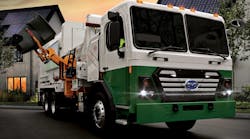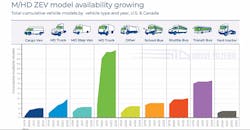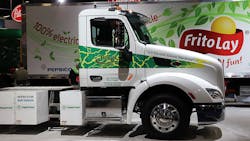The amount of zero-emission trucks, buses and off-road equipment to choose from in the U.S. and Canada will increase 78% year-over-year, according to projections from the Zero-Emission Technology Inventory (ZETI). As of 2019, there were 95 medium- and heavy-duty models in production; by the end of 2020 there will be 169.
ZETI, which was started in March this year by clean transportation accelerator CALSTART’s Global Commercial Vehicle Drive to Zero program (Drive to Zero), also estimated a more modest incremental increase through 2023, when the available number will be 195.
Drive to Zero’s stated mission is “to make ZE commercial vehicles commercially viable by 2025 and dominant by 2040 in specific vehicle segments and regions through a strategy, the Beachhead Strategy, designed to catalyze the ZE commercial vehicle segment.”
The need to move towards these goals has been expounded by current events.
"COVID-19 has brought into sharp focus just how critical our e-commerce, shipping and transportation industries and the vehicles that power them are to our worldwide economy, our health and our daily lives,” said Bill Van Amburg, CALSTART’s executive vice president. “Now as we recover from these unprecedented challenges, we must embrace the immediate opportunity to transform transport with the clean technologies becoming available, and strongly support the innovators ready to build, buy and use them.”
Here is a breakdown of how each market will grow to meet those demands.
“The 2020 growth curve can be tracked to a number of factors — the biggest one being demand,” said Dr. Cristiano Façanha, Drive to Zero’s global director. “Local, regional and state governments as well as corporate innovators have set strong commitments for fleet electrification, and manufacturers want to supply the vehicles they require.”
As of 2019, the transit bus segment had the highest quantity, just over 35 model options. By the end of this year, the medium-duty market, which started 2019 at under 20, will grow 300%, with about 66 available configurations.
The numbers are a bit misleading as the medium-duty truck space has several battery conversion kits for various body types and vehicle chassis for box and straight trucks, and each configuration counts as one unit.
This does represent great opportunities for fleets to spec their trucks more optimally to the application, particularly in last-mile delivery.
IKEA, which relies typically on Class 4 and 5 box trucks, has a global goal to provide zero-emissions home deliveries to all customers by 2025, starting with New York City and Los Angeles, said Steve Moelk, project implementation manager for IKEA's Zero Emissions Delivery business unit.
In Shanghai, the company currently completes 900 daily deliveries using battery-electric trucks.
Moelk stated the electrification push will start this year, “barring any delays.” These may include numerous external factors, such as COVID-19 and growing civil unrest.
Because of the short delivery routes, long dwell times and urban drop-offs, home delivery is a sensible application in which to deploy BEVs, Moelk said.
“We believe the technology on the vehicle side, infrastructure side and software exists today to meet our goals,” Moelk said. “And I’m sure the technology is going to get better over the next couple of years.”
The main challenges are how to offer lease and rental options to independent drivers, “which may require a little more financial innovation.”
The logistics flow also needs to adapt better to the EV model as well, along with charging availability, he said.
Heavy-Duty: Slow and Steady
The greatest rate of growth through 2023 will be in the heavy-duty market, which right now has a rather paltry arsenal. At the start of 2019, there were six zero-emissions choices. By 2023, ZETI has that number at 19, a nearly 400% jump. The reason the overall volume will remain relatively low by then is attributed to the rigorous testing and robust requirements of heavy-duty trucks. Another reason is those Class 8 refuse trucks, such as the BYD 8R Class 8 Automated Side Loader pictured above, or Mack's LR Electric, which FleetOwner test drove in January, are listed in the "Other" category.
“It will take a longer period of time for zero-emission technology to meet some of the duty cycles, distances and payload capacities that heavy duty trucking fleets need to reliably perform their duties,” said Benjamin Mandel, Northeast regional director at CALSTART.
Some notable Class 8 BEV's charging forward in the next two years include the Freightliner eCascadia, Kenworth T680, Lion8, Peterbilt 579EV, Volvo VNR Electric, and XOS (formerly Thor) ET-One.
In 2023, Nikola, which recently went public, should have its fuel cell electric trucks (FCETs) ready for purchase.
The clear push for all of these new zero-emissions models rolling off assembly lines in the coming years is due to the focus efforts on meeting emissions goals set by cities, states and nations across the globe.
About 10% of the transportation sector, particularly the diesel heavy-duty trucks and buses generate 50% of carbon emissions and two-thirds of the NOx emissions, pointed out Aaron Gilmore, vice president of BYD’s North American electric truck division.
BYD has manufactured 60,000 BEV buses and 13,000 BEV trucks worldwide, but few in the U.S., Gilmore said. However, he added the market is “on the cusp of change.” Ports, drayage, regional hauls and refuse applications all represent promising entry points for both medium- and heavy-duty electric trucks, he said.
“A lot of concentrated electrical power is going to be needed in locations in order to make sure charging can happen,” Gilmore acknowledged, adding utilities are becoming more ready to meet that demand.
The increasing number of choices does make choosing the right fit for growing zero-emissions fleet more complex. Should one wait for hydrogen-powered fuel cell electric trucks to join the market or jump on one of the major OEM's BEV offering sooner? What incentives to defray cost are available? When does a fleet need to meet emissions standards to operate in California?
To help fleets understand all these challenges, Drive to Zero released the Policies and Actions Toolkit, an online compendium of strategies that acts as a quick resource to help potential zero-emissions customers understand policies, regulations, incentives, infrastructure, and investments.






